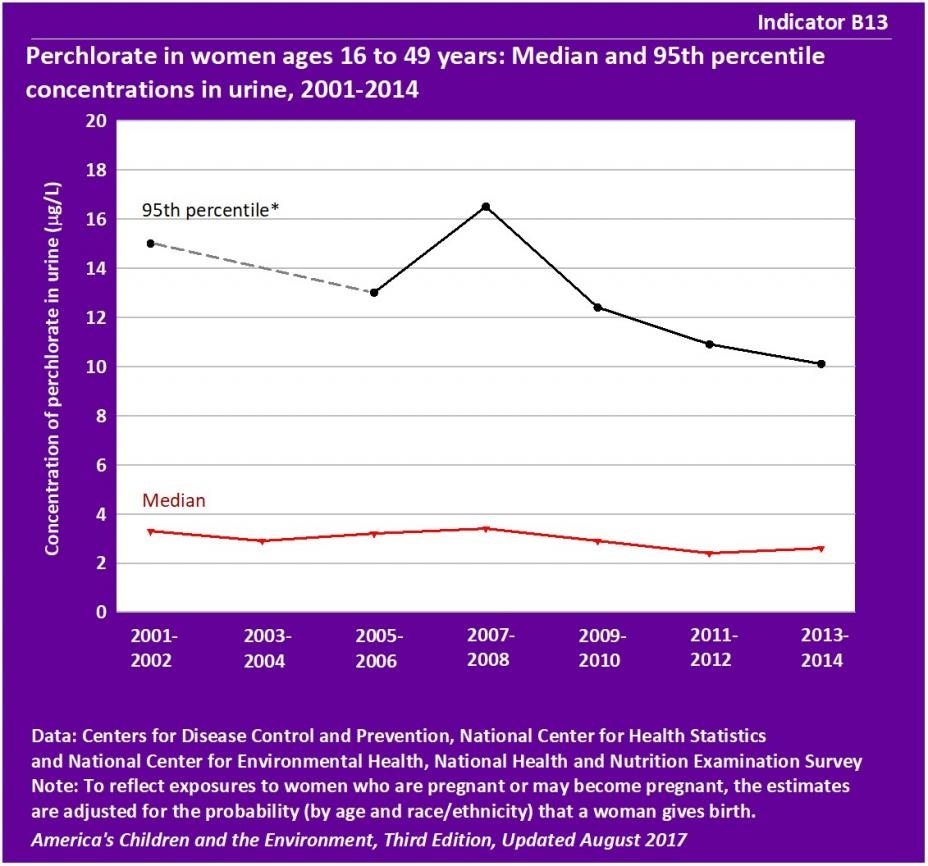ACE: Biomonitoring - Perchlorate
- Indicator B13 – Perchlorate in women ages 16 to 49 years: Median and 95th percentile concentrations in urine, 2001-2014
- Background Text
- Methods
- Data for this indicator are obtained from an ongoing continuous survey conducted by the National Center for Health Statistics.
- Survey data are representative of the U.S. civilian noninstitutionalized population.
- Perchlorate is measured in urine samples obtained from individual survey participants.
- From 2001-2002 to 2007-2008, the median level of perchlorate in urine among women ages 16 to 49 years was 3 µg/L with little variation over time. From 2007-2008 to 2013-2014, the median level decreased from 3.4 to 2.6 µg/L.
- The decreasing trend from 2001-2002 to 2013-2014 was statistically significant.
- From 2001-2002 to 2007-2008, the 95th percentile perchlorate levels among women ages 16 to 49 years varied between 13 and 17 µg/L. From 2007-2008 to 2013-2014, the 95th percentile level decreased from 17 to 10 µg/L.
- The decreasing trend from 2001-2002 to 2013-2014 was statistically significant.
- In 2011-2014, there was little variation in median or 95th percentile perchlorate levels by race/ethnicity or income among women ages 16 to 49 years.(See Tables B13a and B13b.)
- From 2001-2002 to 2007-2008, the median level of perchlorate among children ages 6 to 17 years was 5 µg/L with little variation over time. From 2007-2008 to 2013-2014, the median level decreased from 5 to 3 µg/L.
- The decreasing trend from 2001-2002 to 2013-2014 was statistically significant.
- The 95th percentile perchlorate level among children increased from 15 µg/L in 2001-2002 to 19 µg/L in 2007-2008. From 2007-2008 to 2013-2014, the median level decreased from 5 to 3 µg/L.(See Tables B13c.)
- The decreasing trend from 2001-2002 to 2013-2014 was statistically significant after accounting for differences in sex, race/ethnicity, and income.
- The median perchlorate level among children ages 6 to 17 years was about 46% higher than the level found in women of childbearing age in 2011-2014, while the 95th percentile level among children ages 6 to 17 years was about 21% higher than in women of childbearing age.
- Differences in urinary perchlorate levels by race/ethnicity and income among children ages 6 to 17 years were relatively limited. (See Tables B13d and B13e.)
- The median and 95th percentile urinary perchlorate levels were highest for young children ages 6 to 10 years and lowest for older children ages 16 to 17 years.
- The age group differences were statistically significant for the median, and were statistically significant for the 95th percentile after accounting for differences in sex, race/ethnicity, and income.
Indicator B13
![]()

*The 95th percentile concentration for 2003-2004 is not reported because it has large uncertainty: the relative standard
error, RSE, is 40% or greater (RSE = standard error divided by the estimate).
Data characterization
Background Text
About the Perchlorate Indicator
Indicator B13 presents information about perchlorate levels measured in women. The data are from a national survey that collects urine specimens from a representative sample of the population every two years, and then measures the concentration of various contaminants in urine. The indicator focuses on women of child-bearing age because of concern for potential adverse effects in children born to women who have been exposed to perchlorate.
- Indicator B13 presents concentrations of perchlorate in urine of women ages 16 to 49 years from 2001-2014.
Perchlorate is a naturally occurring and man-made chemical that is used to manufacture fireworks, explosives, flares, and rocket fuel. It is found naturally in groundwater and soils throughout many arid regions; and has been detected in surface water, dairy products, and some food crops. Perchlorate has also been detected in bodily fluids like human breast milk, urine, blood, amniotic fluid, and saliva. It has also been found in some infant formulas.
Exposure to high doses of perchlorate has been shown to block the uptake of iodide into the thyroid gland. This is of particular concern for women of child-bearing age, because thyroid hormones are important for growth and development of the central nervous system in fetuses and infants. Moderate deficits in maternal thyroid hormone levels during early pregnancy have been linked to reduced childhood IQ scores and other neurodevelopmental effects. In 2005, the National Research Council (NRC) concluded that the available epidemiological evidence did not indicate an association with thyroid disorders in adults or infants, and was inadequate for assessing the potential for adverse associations between prenatal perchlorate exposure and adverse neurodevelopmental outcomes in children. The NRC also noted a lack of studies to evaluate potential effects of prenatal perchlorate exposures in infants and children, particularly in vulnerable populations.
Indicator B13 presents perchlorate levels measured in urine of women from the National Health and Nutrition Examination Survey (NHANES).
More information about perchlorate and Indicator B13 is provided in the updated Perchlorate section of America's Children and the Environment, Third Edition.
Related Links
Agency for Toxic Substances and Disease Registry (ATSDR): Public Health Statement for Perchlorates
National Academy of Sciences (NAS): Health Implications of Perchlorate IngestionExit
U.S. EPA: IRIS Assessment of Perchlorate
U.S. Food and Drug Administration (FDA): Perchlorate Questions and Answers
Methods
Summary of Methods - Perchlorate
The National Center for Health Statistics, a division of the Centers for Disease Control and Prevention, conducts the National Health and Nutrition Examination Surveys (NHANES), a series of U.S. national surveys of the health and nutrition status of the noninstitutionalized civilian population. Interviews and physical examinations are conducted with approximately 10,000 people in each two-year survey cycle. The survey measures perchlorate levels in urine samples collected from NHANES participants.
Indicator B13 uses the NHANES data to present median and 95th percentile concentrations of perchlorate measured in urine of women ages 16 to 49.
Detailed Methods for Indicator B13
Metadata for National Health and Nutrition Examination Surveys (NHANES)
